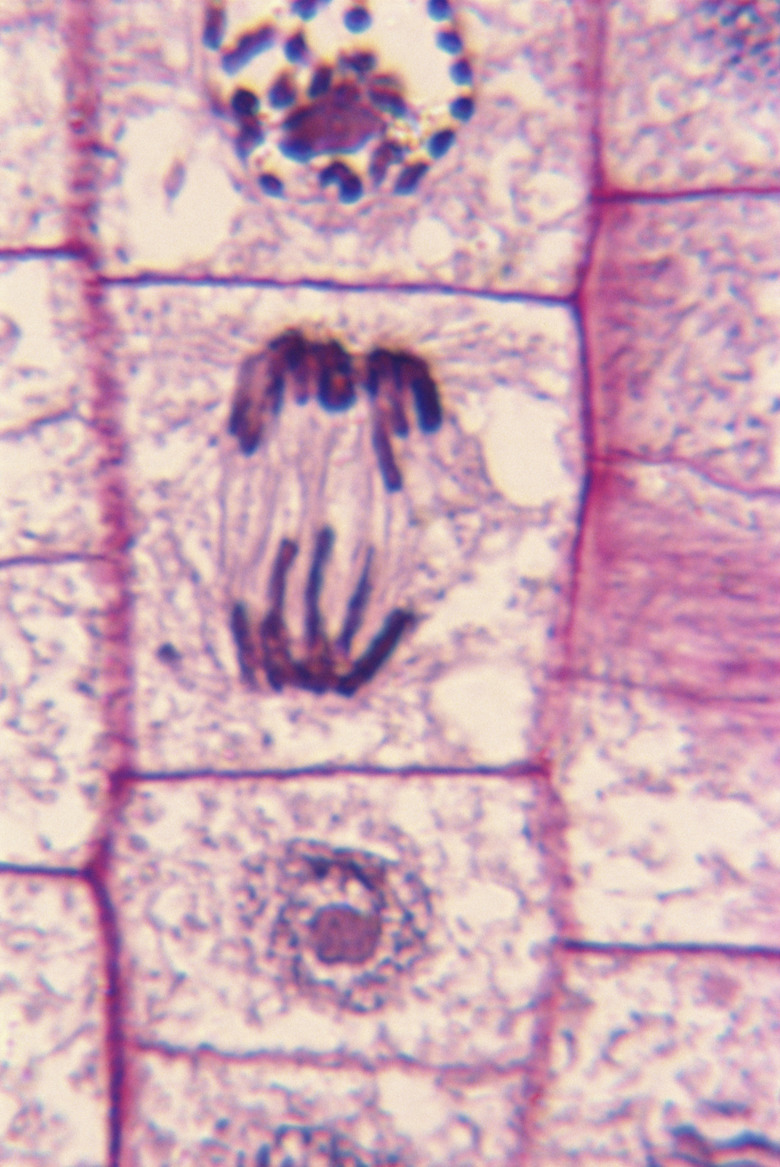What Is Late Telophase?
Mitosis is the division of a eukaryotic cell's replicated genetic material into daughter nuclei. It is preceded in the cell cycle by the replication of this genetic material, which consists of DNA (deoxyribonucleic acid) packaged into chromosomes. Once a cell has two complete copies of its genetic code, it is prepared to separate that material into two compartments and then divide in two altogether to form identical daughter cells.
Mitosis is not the division of a whole cell into two new cells. That process is called **cytokinesis** and logically follows closely on the heels mitosis. However, the distinction between late telophase, the last of the four stages of mitosis, and the beginning of cytokinesis is somewhat blurry.
Chromosomes and Cell Division
Chromosomes and Cell Division
The cells of prokaryotic organisms (bacteria and the single-celled organisms formerly known as archaebacteria) do not have nuclei and do not undergo mitosis. Instead, these cells, and their small amount of DNA, often in the form of a single ring-shaped chromosome, divide in half in the process of _binary fission_. Only eukaryotic cells, including those of animals, fungi and plants, undergo mitosis.
The DNA of eukaryotes is typically packaged into dozens of chromosomes; humans have 46. Chromosomes are individual pieces of chromatin, which is a blend of DNA and structural proteins.
These organisms exhibit a **cell cycle**, which begins with the G1, S and G2 stages of what is collectively termed interphase and ends with M phase (mitosis and cytokinesis).
Mitosis: Definition and Summary
Mitosis: Definition and Summary
Mitosis is classically divided into four phases, although some sources include a fifth, called prometaphase, between the first and second.
**Prophase:** In this phase, the chromosomes condense from loose tangles of DNA into more well-defined structures. The mitotic spindle, which will eventually pull the chromosomes apart, forms at the poles, or opposite sides, of the cell.
**Metaphase:** The chromosomes, which exist at this point as duplicated sets (sister chromatids) joined at a point called the centromere, migrate to the center of the cell and form a line there, called the metaphase plate.
**Anaphase:** This is the most dramatic phase of mitosis, when the sister chromatid are pulled apart at the centromeres and move to opposite poles of the cell. Cytokinesis actually begins in anaphase.
**Telophase:** This process is essentially a reversal of prophase; the chromosomes de-condense, and a new nuclear membrane forms around the two new chromosome sets.
Telophase of Mitosis
Telophase of Mitosis
While anaphase gets the credit for separating the sister chromatids into twin sets, it is in telophase that two new complete nuclei are formed. The main feature of telophase is the synthesis of nuclear membranes around each chromosome cluster, partitioning them from the cytoplasm.
During telophase, the chromosomes uncoil and assume the diffuse physical state in which they spend most of the cell cycle. At the same time, cytokinesis is well underway on either side of the daughter nuclei.
If you're ever asked to explain the difference between telophase and cytokinesis, say, "Telophase refers to the formation of two new nuclei. Cytokinesis refers to the formation of two new cells."
Cytokinesis
Cytokinesis
The distinction between late telophase and the point at which only cytokinesis is occurring is rather like the distinction between childhood and adolescence: realistically, there is no bright line between them.
Cytokinesis starts during anaphase of mitosis with the appearance of a cleavage furrow, an indentation on the cell surface that makes its way around the entire cell.
The mechanism of the separation of the cell is a protein-rich structure in the cytoplasm, just inside the cell membrane, called the contractile ring. As this ring contracts and its diameter shrinks, it physically cuts the cell in half, a process that occurs sometime after the nuclear membranes generated in late telophase are fully formed.
Cite This Article
MLA
Beck, Kevin. "What Is Late Telophase?" sciencing.com, https://www.sciencing.com/late-telophase-14137/. 29 April 2019.
APA
Beck, Kevin. (2019, April 29). What Is Late Telophase?. sciencing.com. Retrieved from https://www.sciencing.com/late-telophase-14137/
Chicago
Beck, Kevin. What Is Late Telophase? last modified August 30, 2022. https://www.sciencing.com/late-telophase-14137/
